- Getting the basics down
- Building your battery system
- STEP 1: Working out current draw
- STEP 2: Choosing your battery
- STEP 3: Isolators, chargers and management systems…Oh my
- STEP 4: Optional extras you should consider solar
- Quick guide: Glossary of terms
It doesn’t matter what, where or how you drive, if you’re heading off-road in any vehicle for any purpose one of the biggest set of decisions you can make is the type of 12V system you’re going to run. After tyres and suspension, getting your electrics dialled in will arguably be the most useful addition to your vehicle, even more so when camping.
The problem is, unless you have degrees in electrical engineering, astrophysics, an IQ in the 200s, your surname is deGrasse Tyson or are some sort of Tesla-spec savant (no judgement, it’s your time to shine), you’re probably not up to speed on the latest advancements in battery technology, 12V accessories or the myriad ways to set yourself up for off-grid electrickery. And to make things worse, over the past decade or so things have moved on from “huh, that’s a nifty gadget” to “that’s outright bonkers”.
Let’s dive in.

Getting the basics down
First things first, we should probably get in to some of the terminology used in this guide. Because 12V chicanery is pretty daunting for the uninitiated, let’s get our head around the basics by using the comparison of electricity to water running through a pipe, and the various devices being the things that impact the flow of that water.
For example: volts, amps and resistance – compare the volts to how much water pressure there is or how much you turn the tap on (in this case, it’ll be pretty much always 12V); the amps, or current, would be the water-pipe diameter (or how big your battery is); and the resistance (caused by, say, a 12V LED light) would be a clod of dirt in the pipe that impedes the current. So the more dirt (accessories) impeding the flow (current), the more it drops.
Got it? Cool, let’s get into the nitty gritty.
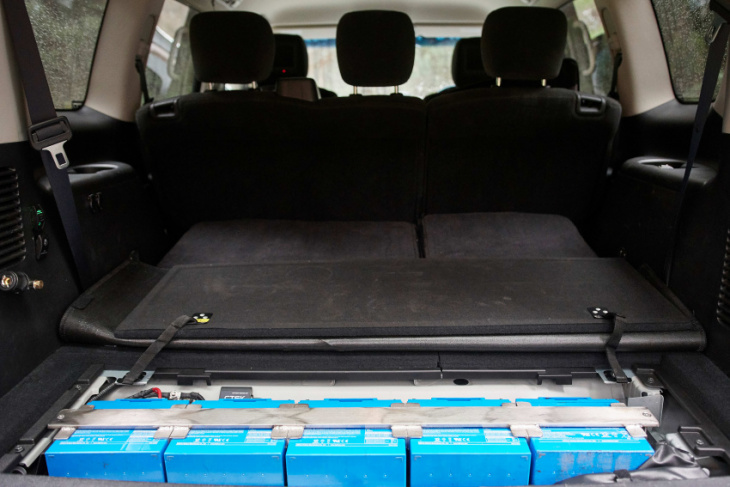
Building your battery system
STEP 1:
Working out current draw
Easily the most subjective part of this process is working out what’s going to suit your needs, but it’s the important first step on your journey to a functional battery system.
Now, say you only need to power a fridge and a couple of camp lights, so your system requirements are going to be very different to your mate, who’s a bit of a glamper and wants to run the same as you but also a second fridge as a freezer, a microwave, a 12V hairdryer and he needs to watch the footy on a Friday night on his 12V telly.
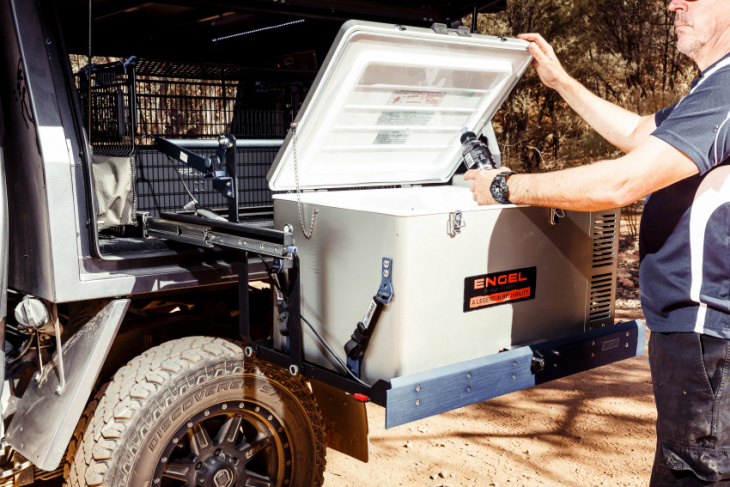
You need the rough current draw for each and every 12V accessory you want to run while the vehicle is turned off. Let’s throw some figures around to give you an idea.
For a fairly standard set-up, say you have a 60L fridge, four LED camp lights and you want to bump some tunes through your 4×4’s stereo (before 9pm and at a reasonable volume, because you’re not a scum queen). Of course, you’re not running your lights or music all the time, so we have to factor in a rough ‘hourly usage’ amount. So, we’ll say you’re running your fridge for a full day of camping (24 hours), your stereo for two hours as you’re making dinner, and your camp lights for four hours as an estimate.
Your fridge will be drawing roughly 85amp/h over 24 hours, your stereo will be 10amp/h and your four lights will be sucking around 8amp/h from your battery. A little addition later and we’re at 103amp/h over a 24-hour period for your battery needs.

Now let’s look at your mate’s requirements. Fridge, stereo and four lights are 103amp/h, but let’s also add in a second, smaller fridge at 70amp/h; a microwave (10 minutes total run time per day) at 30amp/h; a hairdryer (10 minutes per day) at 27amp/h; and the TV (4 hours per day) at 12amp/h. This guy is going to need 242amp/h to get him through a 24-hour period, which is more than double your needs, and will cost a lot more. Knowing your approximate current draw is important, so let’s keep building our 12V set-up.
But before we do, a note on smart alternators
Wait, what the hell is a ‘smart’ alternator?! Ugh. Hands up who loves car manufacturers adding unnecessary complexity to their 4x4s? Yeah, my hand is down too, but let’s have a quick chat about smart alternators.
A decade or so ago some boffin who deserves a Chuck Norris roundhouse to the dome, arbitrarily decided that a standard fixed voltage alternator caused too much mechanical load on a vehicle. So they came up with a system to essentially turn the alternator off once the main starting battery is at full charge and reduce exactly four-fifths of bugger-all load, to increase fuel economy and thereby reduce emissions by what must be truly infinitesimal amounts.
Luckily, they increase complexity and will not charge a secondary battery. Unfortunately, nobody has invented a sarcasm font as yet, so you may have missed that they’re an absolute waste of time.
Luckily (seriously this time) there are a range of battery chargers on the market that will allow a secondary battery to be charged, even with a not-so-smart alternator, but just make sure you know what your vehicle has before laying down your hard-earned. A quick and cheap workaround is to buy an Alternator Output Compensator (AOC) from Piranha Off Road, which will allow your variable-rate alternator to charge a modern battery.

A second battery in the engine bay is a standard set-up
A quick and easy check to see if your vehicle has a smart alternator is to take a look near your vehicle battery (usually around the negative terminal) and see if you can spot a battery sensor module. If you can, you have a smart guy and will need to purchase a charger or AOC that will allow for it. Right, moving on.
STEP 2:
Choosing your battery
There has probably been more advancement in battery technology over the past decade than there has been in the preceding four. The big new player on the scene is Lithium Iron Phosphate (LiFePO4), commonly contracted to just lithium batteries, or there’s the tried-and-true Absorbed Glass Mat (AGM) units, or the cheaper wet cell lead acid types.
We’re going to leave out hybrid cranking/deep cycle batteries for the sake of brevity, but these can be a great secondary battery if you’re running a lot of high current-draw accessories, like a 24V winch or a bevy of halogen lights. For most people though, a dedicated deep cycle auxiliary is the way to go, so we’ll stick to them.
Lead acid (wet cell)
Starting with the cheapest first, these are the batteries for an absolute shoestring budget. Not so long ago, one of these combined with a simple boat battery switch was the way to get yourself a battery system on the cheap; but, to be completely honest with you, there is very little reason to go with a wet cell battery these days – a little more outlay can get you a system that’s orders of magnitude better.
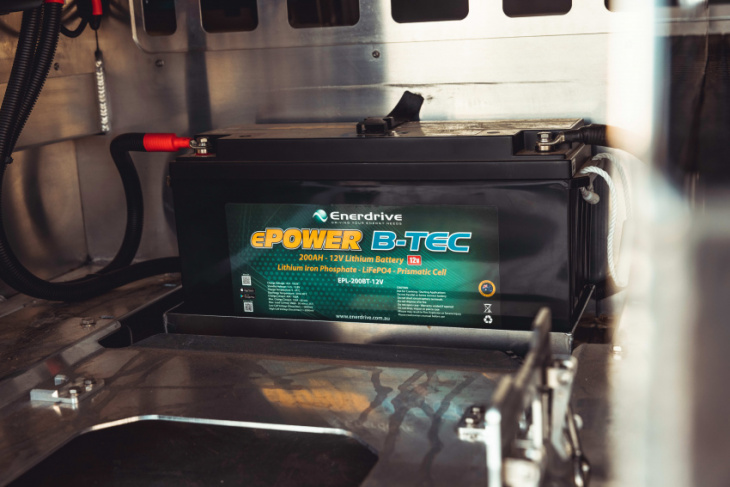
AGM
For the budget-conscious, AGMs are still the pick of the litter. They use a glass weave (think raw fibreglass sheeting) between the plates in the battery which absorbs the acid and lowers the internal resistance, enabling faster charging and delivery of higher current when needed. They can also handle deeper discharges than wet cells and tend to last longer too.
Their big advantage over lithium batteries is their ability to handle heat, so are safe for under-bonnet mounting and they’re a chunk cheaper as well, but after that the advantages run out. Put simply, they’re yesterday’s hero, and lithium is the new hotness. However, if you’re only able to mount an auxiliary under the bonnet, these still tick the boxes.
Lithium batteries
Lithium is the go-to for most modern battery systems. Not to put too fine a point on it, but they take a bat to everything else. About the only reason you wouldn’t go with lithium is price, which frankly, is fair enough given they’re up to 200 per cent more costly than a similar-spec AGM, but note that they can last up to four times as long, so there’s a strong argument they’re actually less costly over their life cycle.

However, they can’t handle heat so under-bonnet installs are out, and they need a special charging profile to work effectively, so you can’t upgrade your AGM-based system with a lithium battery, you’ll likely need to start from scratch.
From there, though, it’s all gravy. Up to 65 per cent lighter, can deliver up to 95 per cent of their current without a massive change in voltage (AGMs can go around 50 per cent – so a 200amp/h AGM is equivalent to a ~100amp/h lithium), charge quicker, and a quality lithium can be drained some 3000 times (vs around 1200 for a good AGM). They’re also available in slimline shape, so mounting behind the rear seat in a dual cab cancels the “I’ve got nowhere to fit it, and I don’t want it in my tub” problem. If the initial outlay is affordable, then lithium is the only choice, hands down.
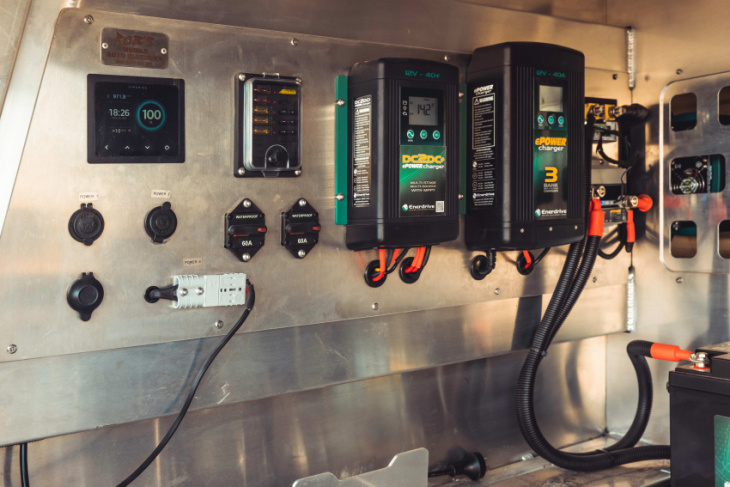
Enerdrive supplies 12V eSystem DIY kits for all touring types
STEP 3:
Isolators, chargers and management systems…Oh my
Or in other words, how to keep your auxiliary battery charged.
Selecting the right charger for the job may not be as easy as it first seems; there are a couple of things you need to factor in before you start shrilly yelling your credit card numbers in to the phone. The three big ones are: Type of battery you have (lithium or AGM etc.); the maximum charge voltage; and the maximum charge current your battery can handle (both figures should be readily available from the manufacturer). Each battery will react differently to different charge profiles, so matching your battery to its charger will not only extend its life, but it’ll also reach 100 per cent state of charge quicker too, so it’s worth getting this bit right.
Let’s say you have a 100amp/h AGM battery with a maximum charge current of 30amp and maximum charge voltage of 13.8V, you would look for a charger with a max current of 30amp to keep things on the safe side. Makes sense when you think about it, eh? Sticking a charger in with 50amp maximum current would most likely kill your battery fairly quickly. Got it? Awesome, let’s take a look at the charger options.
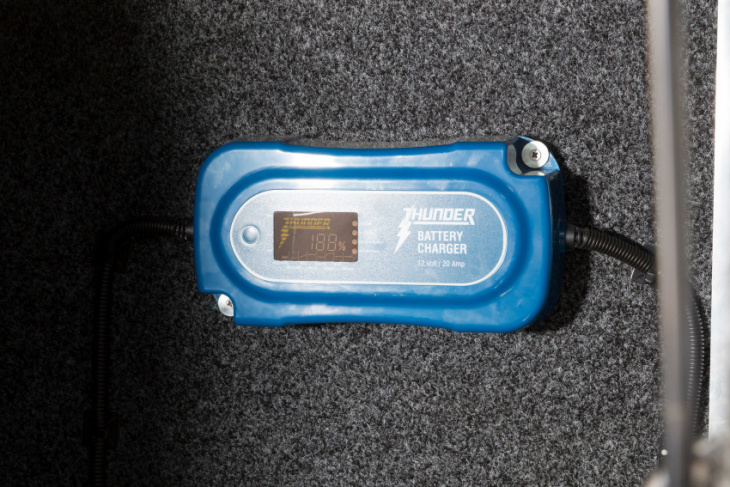
Boat switches
Back in the days before smart alternators, specific battery charge profiles and the internet, it was a whole lot simpler to get an auxiliary deep cycle installed in your rig. Basically, all you needed was a means of securing your second battery, some cabling and a marine battery switch that directed charging current from your alternator to either of your batteries with a flick of a dial. You charged up your auxiliary while driving, then flicked it back over to your starting battery when you’d pitched camp. Dead simple, cheap and foolproof … until you forget to switch things over and you end up draining your starting battery and stranding yourself.
Many newer (read: better) batteries won’t be compatible with this type of switching system considering the range of charging profiles. Given the proliferation of modern battery chargers these days, unless you’re powering up a paddock basher with a few camp lights and an old wet cell, there is little reason to be running a boat-switch system.
Think of it like this: not that long ago it was considered cutting edge to have a device in your pocket that could contact another human being; nowadays the pocket-device can access all of the knowledge known to mankind and do a whole lot more.
It can still make a call, but the scope of its function has grown exponentially. Battery chargers are the same, and there’s so few reasons to be carrying a Nokia 6210 around today.
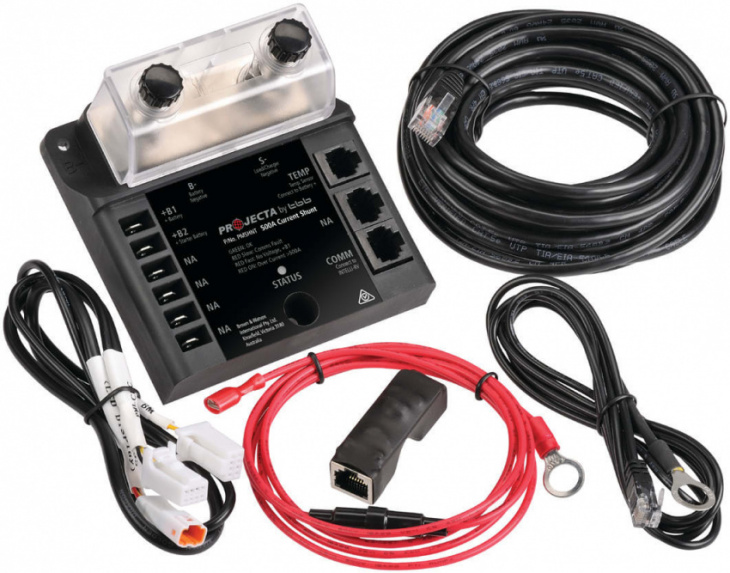
12V electrics add sophistication to today’s 4×4 tourer
Isolators
The next step in dual-battery charging evolution is the humble battery isolator. These should be considered the entry-level charging system for most modern systems and offer terrific bang for buck as a starting point; however, they do lose out on some of the perks of a more comprehensive set-up. But we’ll get to that in a minute.
Essentially, an isolator will use a microprocessor to determine when your starting battery is fully charged and then direct current from the alternator to your auxiliary, allowing it to gain full charge as well. They will also prevent your starting battery from being drained by your auxiliary when at camp, so you’ll always be able to kick your vehicle in to life. They will also isolate the starter and auxiliary batteries if the latter is being fed by an external source like solar. They’re undoubtedly a nifty inclusion to any 12V set-up, but there are still options that can do things bigger, faster and stronger.

A lithium fridge can ease the load on a 12V power system
DC-DC chargers
This is where stuff starts getting good – a DC-DC charger, when paired with the right battery, is a game changer. Many of the upper-end versions of these things incorporate multi-power point tracking (MPPT) regulators (a fancy way of saying they can run solar), a voltage booster so your smart alternator doesn’t tap out when trying to charge your auxiliary battery, and pretty much do everything but stroke your hair and tell you everything is going to be okay. They can even, when used in conjunction with a smart isolator, jump your starting battery from your secondary unit.
For quite a few years these were considered the bee’s knees of dual batteries, but then nerds in white coats went and outdid themselves and came up with …

Redarc Manager watches over the entire 12V system
Battery management systems
The Cohibas of the battery charging world, a standalone BMS is the latest and greatest thing since sliced beer. These little technological marvels allow you to do everything but achieve nuclear fusion, and that’s probably only because we haven’t found the button for it yet.
They’ll charge any type of 12V battery; they can receive charge from 240V, 12V-DC from your alternator (smart or dumb) and solar; and they’ll tell you the percentage your battery is charged and tell you how much time you have until its flat … the list goes on.
Look, if you’re cruising the net for one product that can do up to six other products’ job, this is where you need to be looking.

There are even options on the market, such as Redarc’s Manager 30 and Red Vision systems, that can oversee your entire 12V set-up including fuses and the ability to control your fridge temp, camp lights, stereo and just about anything else on your vehicle that uses electricity. It’s the equivalent of an old guy rocking up in a DeLorean and saying that where we’re going, we don’t need roads. Welcome to the future, fam.
STEP 4:
Optional extras you should consider solar
You’re planning on staying at camp for more than a couple of days? No-brainer, you need solar. To break it down as simply as possible, solar panels or blankets are rated in watts – the higher the wattage the better. Easy, right? Then there comes the choice between mono-crystalline panels and poly-crystalline panels. To be honest, this is an entire article on its own, but the short and curlies is to get monocrystalline panels – they’re better. Fight me.
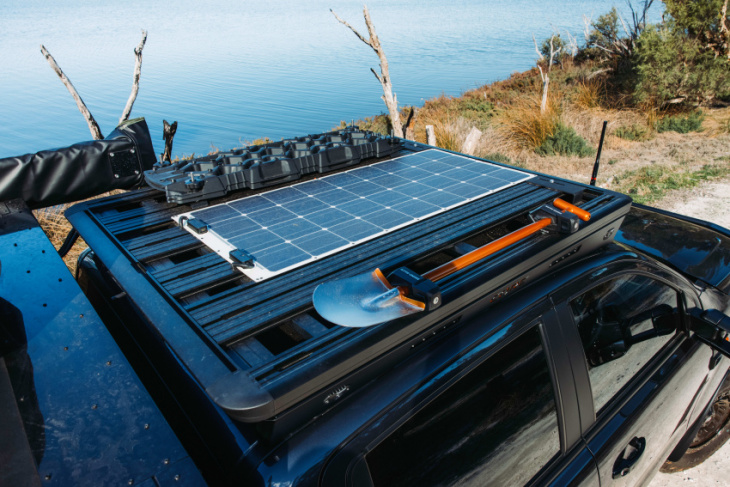
Then you have the whole regulator debate. Again, to put it as concisely as possible, multi-power point tracking (MPPT) is the business, don’t settle for anything less.
Hard-mounted versus soft-mounted (blankets or removable stands) are entirely subjective and there are multiple arguments for both. Ideally, get yourself a combo – a hard mount on the roof for when you’re driving, then a moveable unit that can be directed at the best angle for sunlight while at camp. However, we’re not here to tell you when to turn your snags on the barbecue.
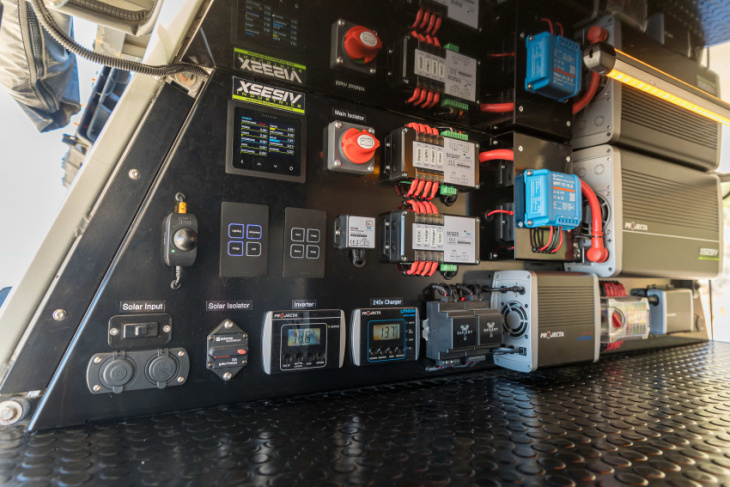
Properly arrayed and labelled 12V system is a work of art
Power distribution
POWER distribution blocks are fantastic for providing a ready mount switch panel, every outlet from USBs to Anderson plugs and accessory fuses in one handy location. Readily available and well-priced, these can make installing a range of aftermarket 12V gear 100 times easier and keep things neat and tidy.
Shunts
Remember back in the 1990s when you had that sweet-as battery monitor in a fancy LCD display sitting proud on your LandCruiser’s dash? Yeah, we’re trying to forget those days too, and helping us with that particular facepalm is the new crop of smart shunts. Essentially a battery monitor, but instead of having to mount it to your dash and lower your dad’s opinion of you, they beam your battery status straight to your smartphone via Bluetooth. You don’t even have to leave your camp chair to know how your auxiliary battery is handling life.
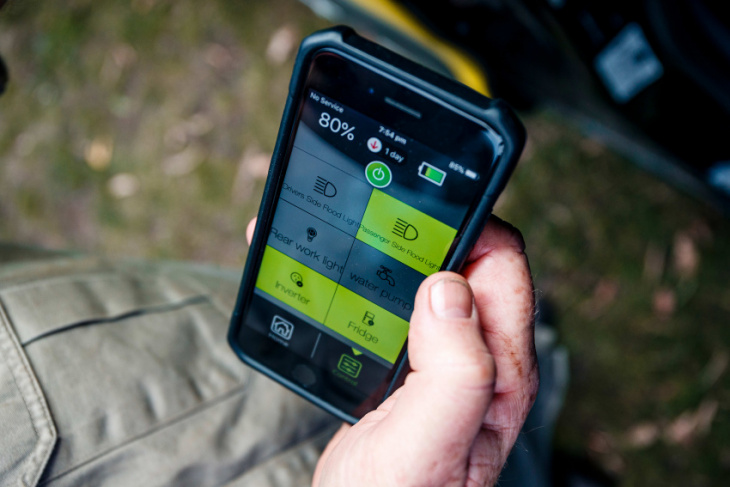
Today you can monitor and control the 12V via a phone
Low voltage protectors
One of the main advantages of lithium is that you can get a lot of volts right up until the battery is nearly dead, then without warning you’ll be powerless and wondering why the hell your Best of Billy Ray Cyrus album suddenly went silent.
This is where a low voltage cut-off comes in to its own. Generally, these are solid state electronics, so no moving parts and ultra-reliable, they sense when the voltage drops below a preset figure and will shut things down, preventing you from completely draining your battery. You may think to yourself, “she’ll be right, I’ll just run the engine and let the alternator charge her back up, I don’t need one!” except that if a lithium battery reaches a deep enough state of discharge, your alternator or solar won’t have enough zap to bring it back to life. That’s when you need a …
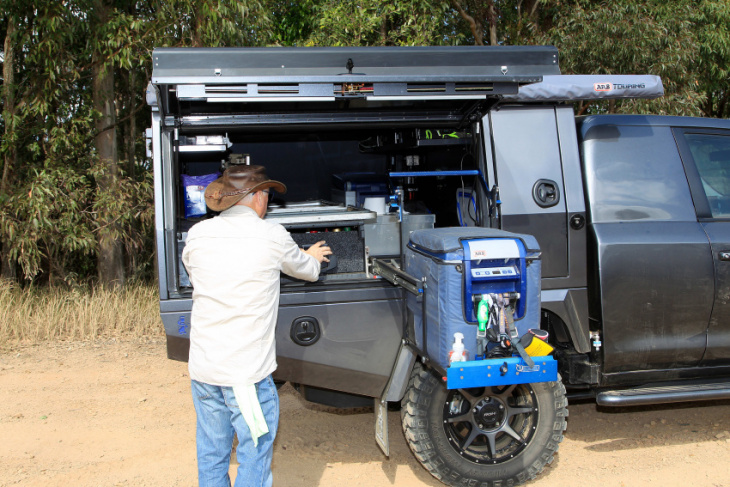
240V charger
It may seem weird to plug your non-electric 4×4 in to the outlet in your garage, but a 240V mains charger will have your lithium up to 100 per cent state of charge quicker and easier, and it’s the only method that will revive a battery that has been severely depleted. These are only really needed for lithium systems and are not an absolute necessity, but they’re damn handy to have when you need one.
Inverters
Selecting an inverter is an essential part of choosing your battery system and is, again, an entire article on its own. The 30-second version of this textbook of info is to work out what 240V (i.e., stuff with a household electrical plug) accessories you’re running and determine the wattage you’ll need to run them, then add 20 per cent on top for safety. Say you want to run a 1000W microwave, you’re better off sourcing an inverter that’s at least 1200W or, preferably, higher.
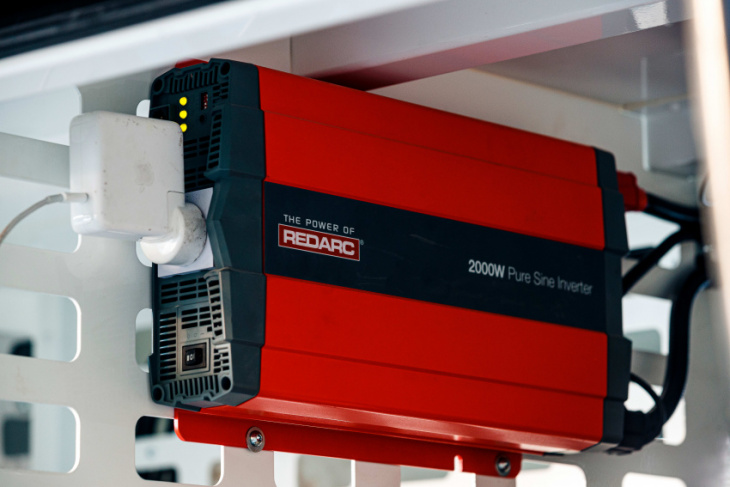
Now, with that said, it’s a fair chunk more expensive to run larger (2000W and up) inverters, everything from having to purchase a larger battery (200amp/h for a 2000W inverter) down to having to run thicker cabling, which adds up quickly, so think long and hard before deciding you can’t live without your Dance Revolution arcade machine while camping. Also, get a Pure Sine Wave unit unless you’re happy to melt your modern electrical devices.
Laying cable
Selecting the correct cable for your install is pretty important. The two main considerations are whether the cable is capable of holding the current you’re going to be sending down it and whether there will be an unacceptable amount of voltage drop along the cable length. To work out current capacity we have to go back to our Electrics 101 high school class and remember that the amps (current) is equal to the watts divided by the voltage.

Say you have a 50W light you want to power, we know the voltage is 12V (actually it’s 13.8ish when your car is running, but let’s not get bogged down with details) so 50/12 gives us a figure of 4.17amp. It’s not a great idea to have a cable that’s operating at the upper end of its capacity, so you’d use wiring that’s rated to 10amp or above in this instance.
However, cable does introduce resistance to the current, and the longer the cable is, the greater the resistance. There is a mathematical formula to work out resistance over cable length, but frankly it’s probably unnecessarily complicated and involves determining the cable’s resistance per metre (in ohms) so we won’t bore you with the brainsplosion.
If you really care, there are plenty of voltage drop calculators online, or you can just use the rule of thumb: if you’re unsure if the wire is suited to the task, go up a size. Because, science.
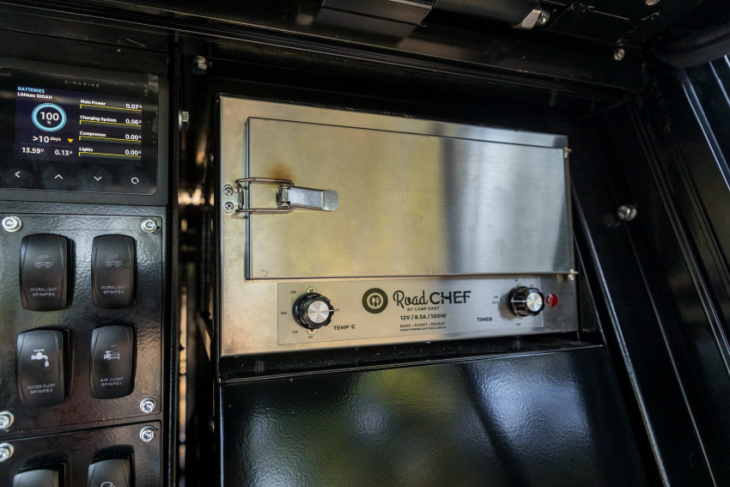
Quick guide: Glossary of terms
AGM: Absorbed Glass Mat; a type of lead acid battery
AMP HOURS: Is a measure of charge or current flow over time. 1amp/h is a current of 1amp flowing for 1 hour
BATTERY ISOLATOR: Used to separate the flow of direct current (DC) to more than one branch in a single direction, allowing two batteries to be charged from one alternator without the batteries being connected in parallel
BATTERY MONITOR: Measures voltage and current in and out of a battery, and tracks the charge remaining
BMS: Battery Management Systems are a comprehensive watchdog for a vehicle’s batteries, and will prevent them from being too drained, overcharged, undercharged and about a billion other things
CURRENT: Voltage divided by resistance gives us electrical current, usually measured in amps
COLD CRANKING AMPS (CCA): The amount of punch a starting battery packs. Basically, the higher the CCA, the quicker it’ll spin your starter motor
CURRENT DRAW: How much battery power a device or accessory needs to run
DC-DC CHARGER: A step up from an isolator, a DC-DC charger will ensure a battery gets the correct amount of charging current for its charge profile, extending its life and speeding up the charging process.
DEEP CYCLE BATTERY: A battery that is designed to be deeply discharged many times over its lifespan, making them ideal for running accessories when the engine is switched off. Modern units are usually AGM or lithium
HYBRID BATTERY: Can be regularly discharged while still providing a substantial number of cold cranking amps. Can be used in either deep cycle or starting roles, and if you can only afford a single battery in your 4×4
INVERTER: A device that takes a 12V input and turns it in to a 240V output. Essentially, it allows you to run household electrical items while you’re travelling remotely
LEAD ACID: A standard wet cell 12V battery, largely superseded but is used in budget builds without a worry
LITHIUM: The new wave of aux batteries that can be discharged deeper and for longer. Pretty much the best you can get, but be warned, cheap lithium batteries are just that and will leave you disappointed
RESISTANCE: A counteracting force against the flow of current. Resistance in a circuit can be introduced by accessories drawing current or faults in the circuit itself
SHUNT: See battery monitor, but its smarter and better-looking brother
VOLTS: Voltage is the force from a battery that pushes charged electrons through the various circuits in a vehicle
12V: Common voltage of almost all modern ICE vehicles
240V: The voltage found in Australian households
WITH THANKSPIRANHA OFF ROAD PRODUCTSwww.piranhaoffroad.com.au
(03) 9762 1200
REDARCwww.redarc.com.au
(08) 8322 4848
COMMENTS
Keyword: Guide to 12-volt systems for your 4x4
